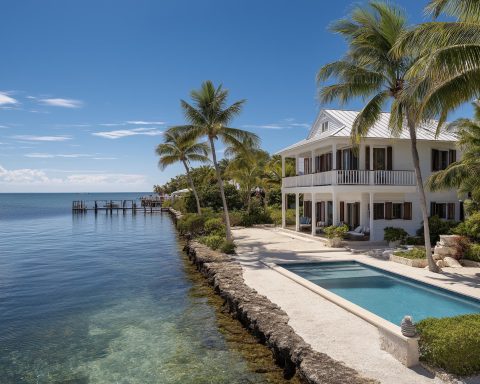Key Facts:
- Monetary Shift: Central banks eased policy – the U.S. Federal Reserve and Bank of Canada each delivered interest rate cuts in mid-September, aiming to spur flagging growth reuters.com. Mortgage rates dipped (30-year U.S. fixed ~6.3% businessinsider.com), fueling a jump in home loan applications businessinsider.com.
- Housing Market Turn: The U.S. housing market tipped toward buyers this summer. Sellers outnumbered buyers by ~35% – the widest gap in at least 12 years – boosting inventory after years of shortage businessinsider.com businessinsider.com. Median U.S. home price is ~$410,800 (Q2), down slightly from 2022’s peak businessinsider.com.
- Mega-Merger: A $1.6 billion brokerage merger was announced Sept. 22: Compass will acquire Anywhere Real Estate (owner of Coldwell Banker, Century 21, etc.), uniting the two largest U.S. realty firms. The all-stock deal creates a colossus of 340,000 agents handling 1.2 million transactions a year resiclubanalytics.com, with closure expected by 2026 pending approvals.
- Global Bubble Check: UBS’s Global Real Estate Bubble Index 2025 flagged Miami as the world’s riskiest housing market, followed by Tokyo and Zurich wealthbriefing.com. Global home prices were flat over the past year (inflation-adjusted) as affordability woes cooled demand wealthbriefing.com. Dubai saw the sharpest surge in bubble risk, after a 50% price jump in five years wealthbriefing.com wealthbriefing.com.
- China’s Slump: China’s housing sector remained in a protracted downturn. New home prices fell again in August (down 0.3% MoM, 2.5% YoY) reuters.com reuters.com despite repeated stimulus. Beijing urged more measures to stabilize demand amid developer debt crises (Country Garden, Evergrande) and sliding sales.
- Middle East Boom: In contrast, Gulf real estate is surging. Saudi Arabia’s residential sales soared +63% YoY in H1 2025 (Riyadh: $17.5 B) amid population growth and megaprojects cbnme.com. A new Saudi law will open select property markets to foreign investors from January 2026, further stoking demand cbnme.com. Dubai and Gulf hubs continue to see robust price gains, though UBS warns Dubai’s market now exhibits elevated bubble risk wealthbriefing.com.
- Europe’s Divergence: Europe’s housing markets showed mixed signals – German home prices rose +3.2% in Q2 (third quarterly gain) as the market finds footing after a deep correction reuters.com, and UK asking prices dipped slightly YoY amid tax hike fears reuters.com reuters.com. However, Europe’s commercial real estate remains in crisis: office property sales are near decade lows reuters.com and office vacancies hit record highs (~20.7% nationally in Q2) reuters.com. “We have ‘zombieland’… no recovery, stranded assets, no liquidity coming back,” warned PGIM’s European real estate head, describing the office sector’s malaise reuters.com.
- Asia Highlights: Japan’s property values are climbing – Tokyo land prices jumped +5.6% over the past year, with peripheral wards seeing double-digit spikes asahi.com asahi.com. New condo prices hit record highs (~¥135 M on average in Tokyo, +24% YoY) amid construction slowdowns asahi.com asahi.com, raising affordability concerns. India remains a bright spot: real estate drew $3.0 B in H1 investment, and “India continues to stand out as a promising country within the Asia Pacific’s real estate investment landscape,” said Colliers India CEO Badal Yagnik ianslive.in.
- Africa & LATAM: Nigeria’s housing deficit is soaring – the government estimates an annual need of ~5 million new homes to keep up with population growth infrastructurenews.ng. South Africa, after four rate cuts since late 2024, sees early signs of property revival amid a 2.3 million-unit housing shortfall ooba.co.za ooba.co.za. In Latin America, high inflation and rates (e.g. Brazil’s Selic at 15% bssnews.net) have cooled local markets, but wealthy Latin American investors are pouring capital into Miami real estate as a safe haven. “When governments in Latin America go left, buyers go North,” observed Miami broker Alicia Cervera, noting political shifts have driven affluent buyers to U.S. property vertical-developments.com.
North America: Housing Shifts and Historic Consolidation
United States – Buyers Gain Leverage: After years of feverish demand and scant supply, the U.S. housing market is tilting in buyers’ favor. New data from Redfin shows home sellers outpaced buyers by roughly 500,000 (35%) in August, the largest surplus since at least 2013 businessinsider.com. This easing imbalance – similar in June and July – has begun alleviating the inventory crunch that defined the pandemic-era boom businessinsider.com businessinsider.com. “The housing market might finally be tipping in your favor,” Redfin’s analysts noted, though they cautioned it’s a buyer’s market “only for those who can afford to buy” amid still-high prices and rates businessinsider.com businessinsider.com. The median U.S. home price sits at about $411k, down a bit from all-time highs but still ~29% higher than five years ago businessinsider.com. With the Fed’s first rate cut since 2024 arriving on Sept. 17 (a quarter-point trim), 30-year mortgage rates have drifted down to around 6.3% businessinsider.com. That’s a far cry from the 2–3% loans of 2021, but the recent dip did spur a 9% jump in mortgage applications in early September businessinsider.com – a sign that sidelined buyers are trickling back as financing costs inch lower.
Commercial Real Estate Crunch: While housing shows glimmers of a thaw, U.S. commercial real estate – especially offices – is in a full-blown slump. Office vacancy rates hit an unprecedented ~20.7% nationally in Q2 2025 reuters.com, double pre-pandemic norms. Major cities are reeling: San Francisco’s office vacancy has exploded to 27.7% (vs. ~8.6% in 2019) reuters.com, and downtown New York is near 23% empty reuters.com. Persistently remote/hybrid work and corporate belt-tightening have left “a glut of empty space…forcing a painful reckoning,” according to Moody’s Analytics data reuters.com reuters.com. Landlords face falling rents and rising financing costs, just as a “debt wall” of $290 billion in office mortgages comes due by 2027 reuters.com. Defaults are climbing, and even regional banks are feeling the strain on their balance sheets reuters.com reuters.com. This commercial downturn is also squeezing city budgets (lower property tax revenue) and stoking debates on converting offices to housing. Industry veterans note a “flight to quality” – well-located, amenity-rich Class A offices are still seeing demand, while older, half-empty buildings languish reuters.com.
Brokerage Giants Merge: A landmark corporate shakeup arrived on Sept. 23 with news that Compass – currently the largest U.S. residential brokerage – will acquire Anywhere Real Estate (the No. 2 brokerage, formerly Realogy) in a $1.6 billion all-stock deal resiclubanalytics.com. The merger, unprecedented in scale, brings famous brands like Coldwell Banker, Century 21, Sotheby’s International Realty, Corcoran and more under Compass’s umbrella resiclubanalytics.com. The combined entity will boast 340k agents across the U.S. and globally, responsible for over 1.2 million home sales annually resiclubanalytics.com. This massive consolidation – slated to close in late 2026 – reflects intense pressure on the brokerage industry. Home sales volumes are near 30-year lows, and high mortgage rates have pinched transactions (2025 existing-home sales are tracking at their slowest pace since 1995). By joining forces, Compass and Anywhere aim to cut costs (an estimated $225 M in synergies) and leverage new scale in technology, referrals, and mortgage and title services resiclubanalytics.com. Analysts say the deal is also a strategic play against Zillow’s dominance: Compass’s CEO Robert Reffkin has long pushed “private exclusive” listings marketed off-MLS, and absorbing Anywhere’s networks could give Compass more control over inventory – potentially challenging the traditional MLS system and listing portals resiclubanalytics.com resiclubanalytics.com. “It’s the biggest brokerage consolidation in U.S. history,” said housing analyst Lance Lambert, who noted it represents a “dominant share of U.S. transactions” now under one roof resiclubanalytics.com. Realtors on the ground will be watching how this mega-broker integrates operations – and whether competitors like Zillow or RE/MAX counter with moves of their own.
Canada – Rate Relief Boosts Outlook: Canada’s housing market is cautiously looking up after the Bank of Canada cut its key rate to 2.5% on Sept. 17, the first cut since March reuters.com. The quarter-point reduction (a unanimous decision by policymakers) comes as Canada’s economy has slowed and the job market weakened. BoC Governor Tiff Macklem cited “a weaker economy and less upside risk to inflation” for the cut reuters.com and signaled the bank is prepared to ease further if needed reuters.com. Mortgage rates in Canada have responded: 5-year fixed loans fell below 4% for the first time in over a year, according to RBC data. This monetary relief is expected to reinvigorate buyer demand heading into the fall. Canada’s housing had been in a funk through 2024 under rate pressure, but as of August 2025 sales were rebounding for a fifth straight month nerdwallet.com. The Canadian Real Estate Association reported national home sales +1.1% MoM in August, with particular strength in Vancouver and Montreal stats.crea.ca. Prices have stabilized – the average home costs about C$687k, roughly flat versus a year ago wowa.ca. Supply remains a concern; new housing starts are down, and economists warn of a possible “surplus to shortage” swing if demand resurges kelownarealestate.com. Policy-wise, the federal government launched a new Build Canada Homes program in September aimed at accelerating construction, and some provinces are expanding incentives for first-time buyers. For now, buyer sentiment has improved with rates off their peak. However, any market revival faces limits: household debt in Canada is near record highs, and regulators are watching for renewed overheating as borrowing costs fall.
Europe: Cooldown for Homes, Crisis for Offices
Housing Markets – Slow Growth, High Hopes: Europe’s residential real estate is navigating a soft landing after the pandemic boom. In Germany, latest data show home prices rose 3.2% in Q2, marking the third consecutive quarterly gain reuters.com. This recovery comes after a sharp correction in 2022–23, when soaring inflation and ECB rate hikes ended a decade-long housing rally. The recent uptick – though slightly smaller than Q1’s 3.5% – suggests Europe’s largest economy may have found a floor in its property market reuters.com. Germany’s government has intervened to prop up developers (several high-profile firms faced insolvency), including subsidies for new construction and looser energy efficiency rules. Elsewhere: France and Spain report modest price growth (~1–3% YoY), while Italy is flat. Sweden and Nordics continue to see slight price declines year-on-year amid high household debt and variable-rate mortgages.
In the UK, house prices are essentially stalling after a multi-year surge. Asking prices in September were 0.1% lower than a year ago – the first annual decline since early 2024 reuters.com. Rightmove data show Britain’s average asking price ~£366k, with weakness in expensive southern England markets dragging the average down reuters.com. “Rumours of property tax changes” (ahead of the Nov. 26 budget) have injected caution, noted Rightmove’s property expert Colleen Babcock reuters.com. Would-be sellers in London and the South are holding off, anticipating possible hikes in capital gains or mansion taxes under the new budget. On the flip side, rent growth in the UK has cooled to 2.4% – the slowest pace in 4 years reuters.com as a slight increase in rental supply and affordability ceilings cap further rent spikes. The Bank of England held its policy rate at 4.0% on Sept. 18 reuters.com, and markets now expect the first BOE rate cut by spring 2026, given inflation has fallen back to ~2.7%. With mortgage rates off their highs (5-year fixes ~4.5% vs 6% last year), British housing activity may pick up in 2025. However, sentiment remains fragile as the economy flatlined in Q3 reuters.com and households face a cost-of-living squeeze.
Europe’s Commercial ‘Zombieland’: The starkest real estate pain is in Europe’s commercial property sector, which one analyst dubbed a financial “zombieland”. Transaction volumes have collapsed – Q2 cross-border investment in Europe, the Middle East & Africa fell ~20% YoY to the lowest in a decade reuters.com. “No recovery, stranded assets, no liquidity,” is how PGIM’s Sebastiano Ferrante characterized the scene, as stubbornly high interest rates and refinancing hurdles freeze deals reuters.com. Would-be buyers are waiting for distressed bargains, but sellers often refuse to accept lower valuations, creating stalemate. Survey data by INREV showed investor sentiment toward European real estate at its weakest in over a year, mirroring the U.S. gloom reuters.com. The office sector is at the epicenter: Germany in particular has been hammered, with investment down another 2% in H1 reuters.com and marquee properties like Frankfurt’s Trianon skyscraper entering insolvency. Banks and funds are now wrestling with how to manage troubled loans – “extend and pretend” loan extensions are common, but some lenders (and regulators) are pushing for sooner write-downs and disposals reuters.com reuters.com. One positive glimmer: segments like logistics warehouses and hotels continue to attract buyers seeking inflation-hedged income reuters.com. And Europe’s perpetual housing shortage means rental housing projects are still getting funded, even as offices languish reuters.com. Overall, however, higher borrowing costs, construction inflation, and economic uncertainty have many European projects on hold. The European Central Bank paused rate moves on Sept. 11 and signaled rates are at peak reuters.com – a welcome relief, but any significant CRE recovery may lag until deep into 2026 when rate cuts truly trickle through.
Asia-Pacific: Mixed Fortunes – China’s Slide, Japan’s Surge, India’s Resilience
China – Prolonged Property Malaise: China’s once-mighty real estate sector continues to struggle with falling prices and weak sales. Fresh figures showed new home prices in 70 cities fell 0.3% in August (MoM), the fourth straight monthly decline reuters.com. Year-on-year, new home prices are down about 2.5% reuters.com. The ongoing downturn, which began in 2021, has defied numerous policy easing attempts by Beijing. Authorities have cut mortgage rates, lowered down-payment requirements, and even eased homebuying restrictions in major cities – but confidence remains shaken. Two years of developer debt crises (exemplified by Evergrande’s default and Country Garden’s recent restructuring deals) have left buyers wary of unfinished projects and falling values. This week, China’s Premier Li Qiang vowed to “stimulate housing demand” with further measures, amid reports that some cities may introduce outright home purchase subsidies or tax breaks to spur buying. The government is also pressuring state banks to increase home lending and ensure financing for stalled developments. So far, the bleeding hasn’t stopped: property investment is down 12.9% YoY in Jan–Aug 2025 reuters.com reuters.com and many smaller developers face bankruptcy. Housing contributes up to 25% of China’s GDP (directly and indirectly), so the slump is weighing on the broader economy (which grew only ~4.5% YTD, below target). Some analysts see early signs of stabilization – e.g. existing home prices in big cities ticked up slightly in late September, and sales volume in Shanghai and Beijing improved from very low levels after policy loosening. But any recovery is expected to be “U-shaped” at best. “The property sector is still stabilising, despite some volatility, and more effort is needed to support demand,” a National Bureau of Statistics spokesperson said last week reuters.com. Global markets are watching closely, as a hard landing for China’s real estate could reverberate through commodities and finance worldwide.
Japan – Tokyo’s Price Boom: In Japan, a very different story is unfolding: Tokyo’s real estate is surging to new heights, spreading beyond the ultra-central wards. The Tokyo metropolitan government’s annual land survey (released Sept. 16) showed citywide residential land prices jumped 5.6% over the past year, accelerating from 4.6% the year prior asahi.com asahi.com. Notably, growth is no longer confined to Tokyo’s traditional high-end core (the Minato/Chiyoda/Shibuya areas). Adjacent neighborhoods saw the steepest climbs – Meguro and Taito wards spiked ~13.5% year-on-year, ranking among the highest increases in the capital asahi.com asahi.com. This broadening boom is fueled by robust demand and scant supply. “Tokyo could face a future where only the affluent can afford to live in more and more neighborhoods,” warned Toshiaki Nakayama of Lifull’s research institute asahi.com. New construction is not keeping up: only ~2,964 new condos were added in H1 2025 across Tokyo’s 23 wards, down 10.7% YoY asahi.com amid labor shortages and high material costs. As a result, new apartment prices have soared – the average new condo now costs ¥135.3 million (~$925,000), up 24% from a year ago asahi.com asahi.com and an all-time high. With new units so expensive (and often pre-sold to wealthy buyers), regular home-seekers are turning to older homes. The average listing price for a second-hand apartment in Tokyo also breached ¥100 million, staying above that level for three consecutive months asahi.com. On the commercial side, Japan’s recovery from COVID has driven up retail and hotel land values – e.g. land in tourist-heavy Asakusa leapt 25–27% in price, the fastest in Tokyo, thanks to surging tourism and new developments asahi.com. Despite the price frenzy, Japan’s central bank remains ultra-accommodative – the Bank of Japan has kept its interest rates at rock-bottom and only in September started hinting at a very gradual policy normalization. Cheap mortgages (below 2%) and Japan’s economic rebound (GDP +6% annualized in Q2) suggest the property uptrend could continue, though officials are warily monitoring for overheating. Tokyo’s situation – booming prices even as population growth is mild – underscores how decades of ultra-low rates and global investor interest (Japan is seen as stable and cheap vs. other capitals) have made its real estate “only for the rich”, as one Asahi Shimbun headline put it asahi.com.
India – Investment Magnet: India’s real estate sector is showing resilience and attracting robust investment flows. A new report by Colliers highlights that India pulled in $3.0 billion of real estate investment in H1 2025, of which $1.6 B came from foreign investors ianslive.in ianslive.in. While this total was down slightly from the record highs a year prior, investor confidence in India remains strong. “India continues to stand out as a promising country within the Asia Pacific’s real estate investment landscape,” said Badal Yagnik, CEO of Colliers India ianslive.in. Notably, domestic investment in property surged 53% YoY in H1, as local institutions and developers stepped up activity ianslive.in. Key drivers include “strong demand for high-quality spaces” (especially in tech hubs like Bangalore and Hyderabad), ongoing regulatory reforms (e.g. GST simplifications), and anticipation of festive-season consumer spending boosting retail realty ianslive.in. By asset class, residential and office dominated, comprising over half of H1’s investment volume ianslive.in. Even segments like land development and construction financing have picked up, indicating developers are securing capital for new projects ianslive.in. Internationally, India’s growing stature is evident: it rose to 4th place in APAC for cross-border property investment in land and development sites, up from 7th previously ianslive.in. The optimistic outlook has forecasters predicting Indian real estate investment could finish 2025 on a “high note,” with core assets appreciating steadily ianslive.in. The main headwinds are interest rates – the Reserve Bank of India has kept rates elevated at 6.5%, but with inflation easing, analysts think rate cuts in 2026 could further propel the sector.
Other Asia-Pacific Updates: In Southeast Asia, housing markets are generally stable. Singapore saw private home prices up ~2.5% YoY in Q3; the city-state in late September slightly tweaked property cooling measures (easing some rules for foreign buyers) after transactions hit a 3-year low. Malaysia and Thailand are benefitting from Chinese tourist property purchases resuming, though oversupply of condos remains a concern in Bangkok. Australia deserves mention for its recent turnaround: After a brief correction in 2022–23, Australian home prices are rising again across most capitals. In August, national prices rose +0.7% (7th straight monthly gain) amid a classic supply-demand squeeze abc.net.au abc.net.au. The median Aussie home now costs A$848k, up 4.1% from a year ago abc.net.au. Interest rates have finally stabilized – the Reserve Bank of Australia held its cash rate at 4.10% in Sept and earlier cuts are feeding through. Meanwhile, advertised home listings are ~20% below normal levels abc.net.au abc.net.au, creating a “seller’s market” again. “More buyers with less to choose from… that’s what’s driving prices,” as Sydney agent Tina O’Connor put it bluntly abc.net.au. Government programs like an expanded First Home Buyer Guarantee are also boosting demand abc.net.au. Not all is rosy – housing affordability in Australia is near worst-ever levels (it now takes over 11 years of median income to buy a median house in Sydney). But for now, the combination of rate relief, wage growth (highest in 5 years) abc.net.au, and scarce stock is pushing values higher even as the economy slows.
Middle East & Africa: Gulf Real Estate Soars, Africa Strives to Build
Gulf Region – High Growth and New Rules: The Middle East’s property markets continue to thrive on strong economic momentum and reforms. In the Gulf Cooperation Council (GCC) states, real estate has been a prime beneficiary of oil-fueled liquidity and ambitious national visions. Saudi Arabia stands out with staggering growth: A report by Cavendish Maxwell reveals Riyadh’s residential real estate sales hit SAR 65.7 B (~$17.5 B) in H1 2025, up 63% year-on-year cbnme.com. The capital saw over 35,600 transactions in six months (+10% YoY) as the government pushes homeownership (target 70% by 2030) cbnme.com cbnme.com. Jeddah too recorded a 34% jump in sales value cbnme.com. Prices and rents are rising in both cities amid population influx and preparation for mega-events (Riyadh Expo 2030, FIFA World Cup 2034) cbnme.com cbnme.com. Saudi’s development boom – from the NEOM futuristic city to new leisure resorts – is driving housing demand to unprecedented levels cbnme.com cbnme.com. In a landmark regulatory change, Saudi Arabia will allow foreign individuals to own real estate in certain zones starting Jan 2026 (a first for the kingdom beyond specific projects) cbnme.com. Officials expect this to “further heighten demand” and foreign investment in hot markets like Riyadh cbnme.com. Over in the United Arab Emirates, property fever remains high: Dubai home prices are ~20% higher than a year ago, and the city led the world in prime luxury price growth. UBS’s index put Dubai in “elevated bubble risk” territory after its 50% price surge since 2018 wealthbriefing.com wealthbriefing.com. Nonetheless, Dubai’s September sales hit a record monthly high (helped by an influx of wealthy foreign buyers from Europe and Asia). The UAE’s property portals are also attracting big investments – Property Finder (the MENA region’s top realty portal) announced a $525 M funding round led by Silver Lake and General Atlantic on Sept. 9, reflecting confidence in the region’s proptech and data sector generalatlantic.com. Qatar, fresh off hosting the FIFA World Cup, reported ~QR 394 M ($108 M) in real estate sales in just the first week of September arabianbusiness.com, indicating sustained post-event interest (particularly in Doha and The Pearl luxury development). Across the Gulf, governments are balancing growth with caution – e.g. the UAE has imposed stricter oversight on off-plan sales and rent caps to prevent overheating. But compared to other regions, the Middle East’s real estate is firmly on an upswing, buoyed by robust GDP growth, relatively low interest rates (pegged currencies import the Fed’s cuts), and ongoing diversification drives.
Africa – Tackling Housing Challenges: In Africa, real estate news is centered on addressing housing shortages and modernizing cities. Nigeria, the continent’s most populous nation, is grappling with an enormous housing deficit. By one government estimate, Nigeria needs about 5 million new housing units annually to keep up with its surging population growth infrastructurenews.ng. The Ministry of Housing on Sept. 23 highlighted this figure while unveiling an affordable homes initiative targeting low-income families. However, delivering homes at that scale is an uphill battle – high construction costs, limited mortgage availability, and rapid urban migration have so far kept homeownership out of reach for millions. Nigeria’s central bank signaled possible interest rate cuts as inflation has started to ease nigeriahousingmarket.com, which could reduce mortgage rates somewhat. In South Africa, the mood is cautiously optimistic. After a painful interest rate spike earlier, the South African Reserve Bank reversed course and cut rates four times from late 2024 to mid-2025, bringing the prime rate down to 10.75% ooba.co.za. This monetary relief, plus lower inflation (now under 3%), has improved buyer sentiment. Major banks report home loan applications rising again, and house price growth turned positive in 2025 after stagnating last year instagram.com. Still, South Africa faces a housing shortfall of some 2.3 million units ooba.co.za, and its property market is highly bifurcated – upscale neighborhoods in Cape Town and Durban are seeing bidding wars, while many rural and township areas struggle with oversupply and weak demand.
Elsewhere on the continent, Kenya and East Africa are experiencing a construction boom in mixed-use developments and logistics hubs, thanks in part to Chinese infrastructure investments. Egypt is pushing ahead with its New Administrative Capital project: a gleaming smart city in the desert east of Cairo. In late September, Egypt hosted the Cityscape real estate expo where developers showcased hundreds of new projects – from high-end Cairo condos to seaside resorts – hoping to attract both local and Gulf investors (especially as the Egyptian pound’s devaluation makes property relatively cheap for dollar-pegged Gulf buyers). Real estate remains a top investment sector across Africa, but financing costs are a major hurdle – interest rates often range from 15% to 25% in many countries (e.g. Ghana, Nigeria), limiting development. To tackle this, several nations are rolling out real estate investment trusts (REITs) and diaspora bond programs to channel more capital into property. The overall theme is one of pressing need for affordable housing and modern commercial space across Africa, and governments increasingly see real estate development as both an economic stimulus and a social priority. As one Nigerian official put it this week, “Housing is not just about shelter; it’s about jobs, dignity, and the future of our cities.”
Latin America: High Rates at Home, Investment Flows Abroad
LatAm Housing Markets – Pressured by Inflation: Across Latin America, domestic real estate activity in 2025 has been constrained by economic headwinds and high interest rates, even as pockets of strength persist. In Brazil, after a period of rate cuts in 2023, the central bank had to reverse course and hike aggressively, pushing the Selic benchmark rate up to 15.0% by September 2025 bssnews.net to combat resurgent inflation. This has dampened Brazil’s housing market – mortgage volumes are down and home prices nationally are roughly flat year-on-year (with São Paulo +2% YoY, Rio -1%). The Brazilian central bank held rates steady at its Sept. 17 meeting bssnews.net but signaled a “new stage of steady rates” to anchor expectations. Mexico’s housing market is faring somewhat better; interest rates there, while high, have been stable (Banxico’s rate at 11.25%). Mexican home prices are rising ~6% YoY (in nominal peso terms), supported by housing demand in industrial regions benefiting from nearshoring investment. Chile and Colombia saw housing slowdowns in 2024 as central banks kept rates in double digits; however, both are now cutting rates (Chile’s key rate down to 8.5%, Colombia’s to 10.25%), which should gradually revive property sales heading into 2026.
Capital Flight to Miami: A defining trend for Latin America’s wealthy in recent years has been investing in U.S. real estate – particularly South Florida – as a hedge against regional instability. That trend hit new highs in 2025. Miami’s condo market is being significantly driven by Latin American buyers, who see U.S. property as a safe store of value amid political and economic turbulence back home. A study by the Miami Association of Realtors found nearly 50% of new-construction home sales in South Florida over 18 months went to foreign buyers, and roughly 90% of those foreign purchasers were from Latin America vertical-developments.com vertical-developments.com. “Miami remains the No. 1 city in the U.S. for foreign homebuyers,” the report noted, with particularly large inflows from Colombia, Brazil, Mexico, Argentina, Chile, and Peru vertical-developments.com vertical-developments.com. Upper-class Latin Americans are buying both primary residences (for those relocating) and investment properties or second homes. Many deals are done in cash, insulating these buyers from high U.S. mortgage rates vertical-developments.com. “Political and economic instability in a lot of Latin America drives activity in our market,” explains Miami broker Eddie Blanco vertical-developments.com. A string of leftist electoral victories – from Gustavo Petro in Colombia to Lula’s return in Brazil – plus high inflation in countries like Argentina have prompted capital flight. “When governments in Latin America go left, buyers go north,” quipped Alicia Cervera, a veteran Miami developer, summarizing a long-observed pattern vertical-developments.com. For now, Miami developers are actively courting Latin American investors: they hold sales expos in Buenos Aires, Bogotá, and São Paulo to sell Miami high-rises off-plan vertical-developments.com vertical-developments.com. This influx of foreign demand has helped Miami’s property market defy U.S. trends, keeping sales and prices buoyant even as other luxury markets cooled. It’s also creating an interesting feedback loop: Zillow’s recent policy to ban stale off-market (“pocket”) listings was seen as targeting Compass’s practices vertical-developments.com, but some experts say the real battle is that portals like Zillow risk losing relevance if too much inventory trades privately among networks of international buyers resiclubanalytics.com resiclubanalytics.com. In short, Latin American money is propping up segments of the U.S. market – a dynamic likely to continue as long as uncertainty persists in the region.
Outlook: From Wall Street to Shanghai and Dubai to São Paulo, real estate is being reshaped by shifting monetary tides, post-pandemic adjustments, and bold new players. The late-September snapshot shows a world of contrasts: record vacancies and restructuring in some quarters, versus red-hot sales and new peaks in others. As we move into Q4 2025, investors and homeowners alike will be watching central banks (will rate cuts accelerate globally?), government policies (e.g. rent control debates, housing incentives), and any signs of financial stress in overextended sectors. One thing is clear: real estate remains a bellwether for economic sentiment – and right now it’s sending mixed signals. “Broad exuberance has faded,” notes UBS’s Matthias Holzhey of global housing trends, as the froth from the 2021 boom subsides wealthbriefing.com. Yet, in places, new exuberance is arising (witness Tokyo’s and Riyadh’s spurts). Real estate, ultimately local by nature, is reflecting the varied fortunes of each region’s economy. September 2025’s developments encapsulate this divergence – and underscore why the world’s property markets will continue to captivate, and concern, in equal measure.
Sources: Global news agencies and market reports wealthbriefing.com businessinsider.com reuters.com resiclubanalytics.com reuters.com cbnme.com reuters.com asahi.com ianslive.in reuters.com vertical-developments.com, among others. All information is based on reports and data from Sept. 22–24, 2025.










